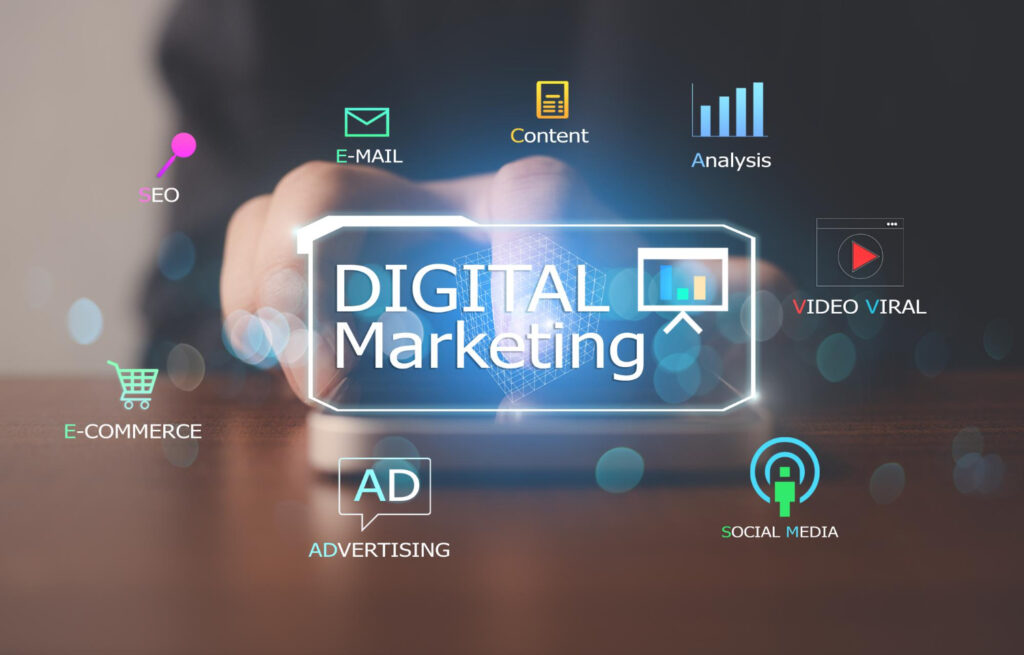

Last updated on
Recently, we discussed how to attract targeted traffic from search engines and addressed the importance of making content sales-oriented in addition to being informative.
Today, we’d like to delve into digital marketing and the tools that can boost sales and significantly impact the quality of leads.
The importance of digital tools in business development cannot be overstated. Analyzing a product or brand can facilitate the development of a market strategy and lead to increased company sales.
The digital marketing department plays a pivotal role in gathering information about the target audience and analyzing the outcomes of brand or product promotions.

This question can be answered by examining the lifestyles of internet users. Almost everyone owns tablets, smartphones, and laptops, and these devices serve purposes beyond leisure and entertainment. They are indispensable for purchasing goods and services.
Users use their phones to order food for home delivery, hail taxis, book plane tickets, and reserve hotel accommodations. Digital marketing serves as an effective means for entrepreneurs to promote their products and engage with customers through these personal devices.
The primary objective of digital communication is to promote and sell a company’s products and services. To sustain user interest in the digital realm, the role of a digital marketer is crucial. It’s essential to engage with the customer at the right moment, precisely when they are receptive to considering the offers they receive.
Digital marketing specialists employ various channels to attract customers. The ultimate goal is driving sales, but it’s important to note that people seldom make purchases immediately after encountering a brand. Marketers employ various strategies to influence users.
There are several channels through which companies can interact with internet users and attract traffic.
Email: Email marketing serves as the initial step in implementing digital tools for your business. Its distinct advantage lies in its ability to reach a contact base of users who are already familiar with your brand and offerings, increasing the likelihood of a positive response.
SMM (Social Media Marketing): Social media platforms provide a valuable means of gathering insights into your audience’s interests. Developers create services within social networks that offer extensive opportunities for engaging with your audience. Additionally, keywords play a pivotal role in enhancing your website’s search engine rankings.
SEO (Search Engine Optimization): This channel revolves around infusing your content with relevant keywords essential for online information retrieval. Paid search promotions and advertising campaigns come into play when organic traffic fails to deliver desired results.
Content: People are more inclined toward useful, educational material rather than overt advertising. Diverse content formats, including graphics, photos, videos, and audio, allow for in-depth exploration and introducing consumers to your product through topic research.
Advertising: Paid tools effectively boost brand visibility and attract active users. Personalized offers during advertising campaigns cater to the specific needs of your website or mobile application audience. When utilizing a mobile app, it establishes direct communication with customers. Developing a company app signifies both promotion and gaining new experiences.
Online PR: Reputation management has transitioned to the online realm with the advancement of digital technologies, particularly gaining traction after the pandemic. Within this channel, managing reviews plays a pivotal role. Effective engagement by the company’s digital specialists in conversations helps preempt conflict situations.
Influencer Marketing: Digital marketing through bloggers has gained prominence. Every internet user has the potential to cultivate an audience around themselves. Many individuals prefer to receive information from people they trust more than traditional sources like magazines and newspapers. Communities surrounding bloggers are of great interest for business development.
Moreover, collaboration with bloggers boasting a million-strong audience isn’t always necessary for successful promotion. Working with accounts featuring several thousand active subscribers is feasible even with a more modest budget. In such cases, analytics becomes essential.

Let’s dissect how digital marketing operates in the promotion of a brand. Here’s how it unfolds:
1. Content Planning: The marketer develops a content plan.
2. Lead Generation: Subscription forms and lead magnets are created to capture potential leads.
3. SMM Specialist: Social Media Marketing specialists craft marketing content on social media platforms, striving to attract more customers, possibly through contests and engaging posts.
4. Email Marketing: An email marketing specialist designs a series of emails, sending them to contacts or recipients who have downloaded the lead magnet.
5. Paid Advertising: Targeters or specialists in contextual advertising promote specific content and initiate advertising campaigns.
6. Coordination: The coordination of efforts among the marketer and other specialists ensures consistent brand recognition and facilitates lead generation, potentially leading to incoming inquiries.
Throughout this process, various digital channels and formats come into play, demonstrating the multifaceted nature of digital marketing in action.
The primary digital marketing tools comprise:
– Content (publishing information on websites, blogs)
– Email marketing
– Advertising (targeted, contextual, display)
– Partner collaborations
– Website
– SEO (Search Engine Optimization)
– SMM (Social Media Marketing)
These marketing tools can be employed individually or in synergy. When used in tandem, they deliver highly efficient brand, product, or service promotion.
Pros:
1. Targeted and contextual advertising introduces the product or brand to a specific and relevant audience (e.g., Yandex Direct and Google Ads).
2. Social media, apps, and viral videos facilitate engagement with a younger audience.
3. Viral content, internet PR, and promotions extend brand visibility to a broader audience.
4. Internet videos effectively demonstrate the benefits of multi-component products.
5. Striking images, dynamic videos, and evoking emotions create a positive mood, a crucial factor since people often make choices based on their emotional state.
In summary, employing digital tools aids in company promotion, fostering interactions with consumers, and building brand loyalty. With a well-crafted strategy and consistent analytics, a company can anticipate increased sales and enhanced product recognition in the market.
If you require consultation on Digital Marketing, we would be delighted to assist you.